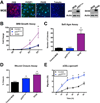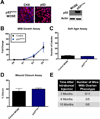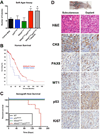Mutant p53 expression in fallopian tube epithelium drives cell migration
- PMID: 25810107
- PMCID: PMC4503498
- DOI: 10.1002/ijc.29528
Mutant p53 expression in fallopian tube epithelium drives cell migration
Abstract
Ovarian cancer is the fifth leading cause of cancer death among US women. Evidence supports the hypothesis that high-grade serous ovarian cancers (HGSC) may originate in the distal end of the fallopian tube. Although a heterogeneous disease, 96% of HGSC contain mutations in p53. In addition, the "p53 signature," or overexpression of p53 protein (usually associated with mutation), is a potential precursor lesion of fallopian tube derived HGSC suggesting an essential role for p53 mutation in early serous tumorigenesis. To further clarify p53-mutation dependent effects on cells, murine oviductal epithelial cells (MOE) were stably transfected with a construct encoding for the R273H DNA binding domain mutation in p53, the most common mutation in HGSC. Mutation in p53 was not sufficient to transform MOE cells but did significantly increase cell migration. A similar p53 mutation in murine ovarian surface epithelium (MOSE), another potential progenitor cell for serous cancer, was not sufficient to transform the cells nor change migration suggesting tissue specific effects of p53 mutation. Microarray data confirmed expression changes of pro-migratory genes in p53(R273H) MOE compared to parental cells, which could be reversed by suppressing Slug expression. Combining p53(R273H) with KRAS(G12V) activation caused transformation of MOE into high-grade sarcomatoid carcinoma when xenografted into nude mice. Elucidating the specific role of p53(R273H) in the fallopian tube will improve understanding of changes at the earliest stage of transformation. This information can help develop chemopreventative strategies to prevent the accumulation of additional mutations and reverse progression of the "p53 signature" thereby, improving survival rates.
Keywords: fallopian tube; high-grade serous cancer; p53 mutation.
© 2015 UICC.
Figures
References
-
- Society AC. Cancer Facts and Figures 2014. American Cancer Society. 2014
-
- Landen CN, Jr, Birrer MJ, Sood AK. Early events in the pathogenesis of epithelial ovarian cancer. J Clin Oncol. 2008;26:995–1005. - PubMed
-
- Medeiros F, Muto MG, Lee Y, Elvin JA, Callahan MJ, Feltmate C, Garber JE, Cramer DW, Crum CP. The tubal fimbria is a preferred site for early adenocarcinoma in women with familial ovarian cancer syndrome. Am J Surg Pathol. 2006;30:230–236. - PubMed
-
- Piek JM, van Diest PJ, Zweemer RP, Jansen JW, Poort-Keesom RJ, Menko FH, Gille JJ, Jongsma AP, Pals G, Kenemans P, Verheijen RH. Dysplastic changes in prophylactically removed fallopian tubes of women predisposed to developing ovarian cancer. J Pathol. 2001;195:451–456. - PubMed
-
- Kindelberger DW, Lee Y, Miron A, Hirsch MS, Feltmate C, Medeiros F, Callahan MJ, Garner EO, Gordon RW, Birch C, Berkowitz RS, Muto MG, et al. Intraepithelial Carcinoma of the Fimbria and Pelvic Serous Carcinoma: Evidence for a Causal Relationship. The American Journal of Surgical Pathology. 2007;31:161–169. 10.1097/01.pas.0000213335.40358.47. - PubMed
Publication types
MeSH terms
Substances
Grants and funding
LinkOut - more resources
Full Text Sources
Other Literature Sources
Molecular Biology Databases
Research Materials
Miscellaneous






